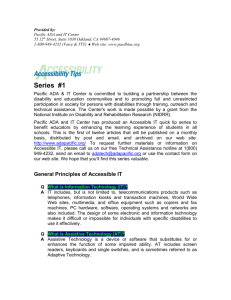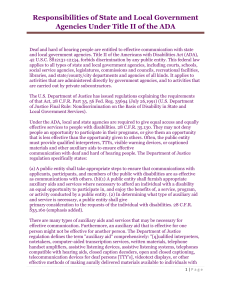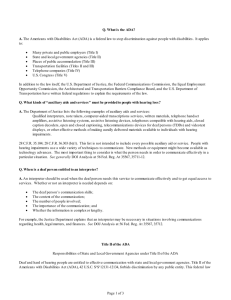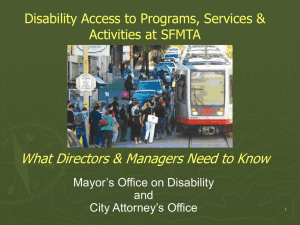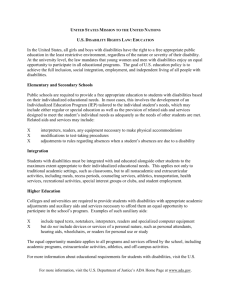State & Local Governments, Effective Communication
advertisement
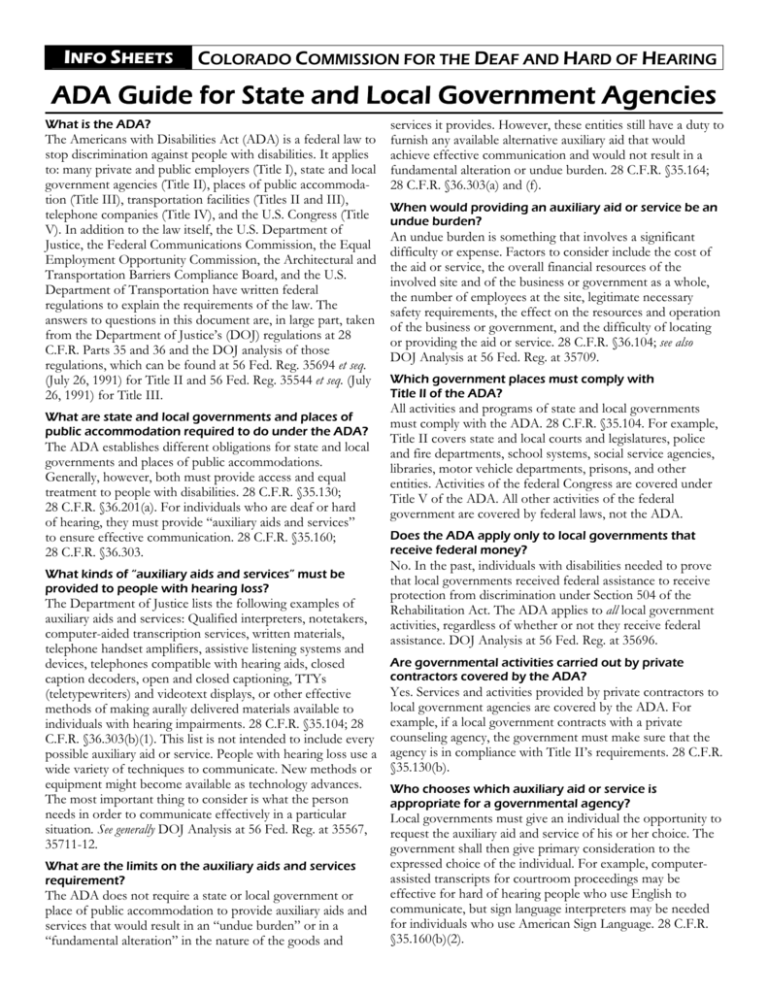
INFO SHEETS COLORADO COMMISSION FOR THE DEAF AND HARD OF HEARING ADA Guide for State and Local Government Agencies What is the ADA? The Americans with Disabilities Act (ADA) is a federal law to stop discrimination against people with disabilities. It applies to: many private and public employers (Title I), state and local government agencies (Title II), places of public accommodation (Title III), transportation facilities (Titles II and III), telephone companies (Title IV), and the U.S. Congress (Title V). In addition to the law itself, the U.S. Department of Justice, the Federal Communications Commission, the Equal Employment Opportunity Commission, the Architectural and Transportation Barriers Compliance Board, and the U.S. Department of Transportation have written federal regulations to explain the requirements of the law. The answers to questions in this document are, in large part, taken from the Department of Justice’s (DOJ) regulations at 28 C.F.R. Parts 35 and 36 and the DOJ analysis of those regulations, which can be found at 56 Fed. Reg. 35694 et seq. (July 26, 1991) for Title II and 56 Fed. Reg. 35544 et seq. (July 26, 1991) for Title III. What are state and local governments and places of public accommodation required to do under the ADA? The ADA establishes different obligations for state and local governments and places of public accommodations. Generally, however, both must provide access and equal treatment to people with disabilities. 28 C.F.R. §35.130; 28 C.F.R. §36.201(a). For individuals who are deaf or hard of hearing, they must provide “auxiliary aids and services” to ensure effective communication. 28 C.F.R. §35.160; 28 C.F.R. §36.303. What kinds of “auxiliary aids and services” must be provided to people with hearing loss? The Department of Justice lists the following examples of auxiliary aids and services: Qualified interpreters, notetakers, computer-aided transcription services, written materials, telephone handset amplifiers, assistive listening systems and devices, telephones compatible with hearing aids, closed caption decoders, open and closed captioning, TTYs (teletypewriters) and videotext displays, or other effective methods of making aurally delivered materials available to individuals with hearing impairments. 28 C.F.R. §35.104; 28 C.F.R. §36.303(b)(1). This list is not intended to include every possible auxiliary aid or service. People with hearing loss use a wide variety of techniques to communicate. New methods or equipment might become available as technology advances. The most important thing to consider is what the person needs in order to communicate effectively in a particular situation. See generally DOJ Analysis at 56 Fed. Reg. at 35567, 35711-12. What are the limits on the auxiliary aids and services requirement? The ADA does not require a state or local government or place of public accommodation to provide auxiliary aids and services that would result in an “undue burden” or in a “fundamental alteration” in the nature of the goods and services it provides. However, these entities still have a duty to furnish any available alternative auxiliary aid that would achieve effective communication and would not result in a fundamental alteration or undue burden. 28 C.F.R. §35.164; 28 C.F.R. §36.303(a) and (f). When would providing an auxiliary aid or service be an undue burden? An undue burden is something that involves a significant difficulty or expense. Factors to consider include the cost of the aid or service, the overall financial resources of the involved site and of the business or government as a whole, the number of employees at the site, legitimate necessary safety requirements, the effect on the resources and operation of the business or government, and the difficulty of locating or providing the aid or service. 28 C.F.R. §36.104; see also DOJ Analysis at 56 Fed. Reg. at 35709. Which government places must comply with Title II of the ADA? All activities and programs of state and local governments must comply with the ADA. 28 C.F.R. §35.104. For example, Title II covers state and local courts and legislatures, police and fire departments, school systems, social service agencies, libraries, motor vehicle departments, prisons, and other entities. Activities of the federal Congress are covered under Title V of the ADA. All other activities of the federal government are covered by federal laws, not the ADA. Does the ADA apply only to local governments that receive federal money? No. In the past, individuals with disabilities needed to prove that local governments received federal assistance to receive protection from discrimination under Section 504 of the Rehabilitation Act. The ADA applies to all local government activities, regardless of whether or not they receive federal assistance. DOJ Analysis at 56 Fed. Reg. at 35696. Are governmental activities carried out by private contractors covered by the ADA? Yes. Services and activities provided by private contractors to local government agencies are covered by the ADA. For example, if a local government contracts with a private counseling agency, the government must make sure that the agency is in compliance with Title II’s requirements. 28 C.F.R. §35.130(b). Who chooses which auxiliary aid or service is appropriate for a governmental agency? Local governments must give an individual the opportunity to request the auxiliary aid and service of his or her choice. The government shall then give primary consideration to the expressed choice of the individual. For example, computerassisted transcripts for courtroom proceedings may be effective for hard of hearing people who use English to communicate, but sign language interpreters may be needed for individuals who use American Sign Language. 28 C.F.R. §35.160(b)(2). Do state and local governments need to make their communications by telephone accessible? Yes. If a local government communicates by telephone with individuals, TTYs or equally effective telecommunications systems must be used to communicate with hard of hearing and deaf individuals. 28 C.F.R. §35.161. Title IV of the ADA requires the establishment of 24-hours-a-day, 7-days-a-week relay services throughout the country by July 26, 1993. 47 U.S.C. §225 et seq. These services may be used by local governments to communicate by telephone with individuals who use TTYs. (In Colorado, use Relay Colorado by dialing 711, or use Online Relay at www.sprintrelayonline.com.) However, governmental offices that have a lot of contacts with the general public by telephone, such as city halls and public welfare offices, are encouraged to have their own TTYs to communicate directly with TTY users. DOJ Analysis at 56 Fed. Reg. at 35712. Must telephone emergency systems be accessible for TTY users? Yes. Local governments that provide 911 and other emergency telephone number services must make sure that TTY users can call those numbers directly, without going through a relay system. 28 C.F.R. §35.162. individuals with disabilities. State and local governments may choose from two design standards in making their facilities accessible: the Uniform Federal Accessibility Standards (UFAS) or the Americans with Disabilities Act Accessibility Guidelines for Buildings and Facilities (ADAAG). If a public entity chooses to follow the UFAS Standards, which do not contain specific guidelines on TTY access, it must nevertheless provide effective communication for its deaf participants. One way of accomplishing this goal would be to use ADAAG’s scoping requirements for guidance on this issue. State and local governments often have licensing and certification programs. Are these also covered by the ADA? Yes. State and local governments cannot establish requirements for licensing or certification programs that discriminate against people with disabilities. For example, a state would not be allowed to automatically exclude individuals with a hearing loss from receiving drivers’ licenses. In addition, local governments must administer licensing and certificate programs (including exams and courses for these programs) in a manner that does not discriminate against individuals with disabilities. 28 C.F.R. §35.130(b)(6). What are the obligations of school systems to comply with Title II? Public school systems must comply with Title II in all of their services, programs, or activities, including those that are open A public entity’s services, programs, or activities, when viewed to parents or to the public. For example, it may be necessary to make auxiliary aids available at graduation ceremonies, parentin their entirety, must be readily accessible to and usable by teacher meetings, plays, adult education classes, and other individuals with disabilities. At times, this may require the events open to the public. DOJ Analysis at 56 Fed. Reg. at public entity to provide accessible telephones in its facilities. 35696. They can fulfill this obligation for deaf individuals by providing public telephones equipped with TTYs or portable Do state and local governments have a duty to notify individuals with disabilities about their ADA rights? TTYs available on request. See generally 28 C.F.R. §§35.150; Yes. Title II requires state and local governments to distribute 35.160. information about their ADA duties to people with disabilities. When do state and local governments have to provide For example, governments can distribute this information captioning? through pamphlets, posters, or television broadcasts. If Television and videotape programs that are produced by state television broadcasts are used, they must be captioned. and local governments should be captioned for individuals 28 C.F.R. §35.106 who are deaf or hard of hearing. DOJ Analysis at 56 Fed. Reg. How does a person with a hearing loss file a complaint at 35712. Do local governments need to provide TTYs at pay phones? When must state and local governments provide effective communication in existing facilities? A state and local government must provide effective communication in an existing building if doing so would not cause an undue burden for that government and would not result in a fundamental alteration in the government’s program or service. 28 C.F.R. §35.150(a). Must state and local governments provide effective communication in new and altered buildings? Yes. All public facilities newly constructed or altered after January 26, 1992 must be readily accessible and usable by against a state or local government under Title II? Title II requires local governments with 50 or more employees to have grievance procedures to resolve Title II complaints. 28 C.F.R. §35.107(b). In addition, individuals may file complaints with the U.S. Department of Justice, or with one of eight other federal agencies responsible for enforcing different subject areas of Title II. 28 C.F.R. §35.190. Individuals may also bring a lawsuit in federal court. 42 U.S.C. §12133. Please contact the CCDHH office for information, referrals, training, and other services for government agencies, businesses, and individuals. COLORADO COMMISSION FOR THE DEAF AND HARD OF HEARING Address: 1575 Sherman Street, 2nd Floor • Denver, Colorado 80203 TTY: 303-866-4734 • Voice: 303-866-4824 • Fax: 303-866-4831 Email: Deaf.Commission@state.co.us • Website: www.cdhs.state.co.us/Deaf Commission The information represented here is adapted from “ADA Questions and Answers for Deaf and Hard of Hearing Individuals” which is part of the Americans with Disabilities Act Communication Accommodation Project, prepared by the National Center for Law and Deafness at Gallaudet University, and funded by a grant from the U.S. Department of Justice.

